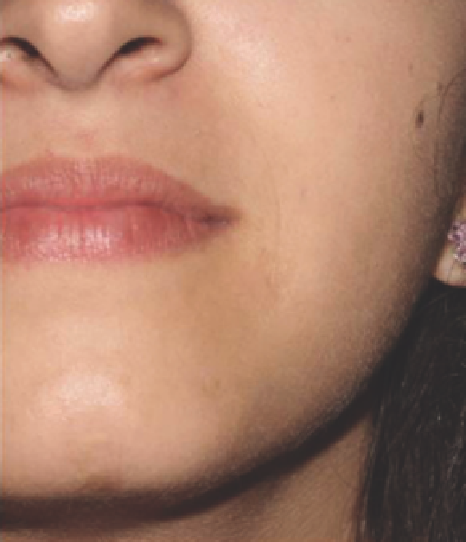Biomedical Engineering Reference
In-Depth Information
(
A
)
(
B
)
Figure 9.14
(
A
) Irregular atrophic acne scars that had been excoriated. (
B
) Six months following two spot treatments with Fraxel Re:Store using 30 mJ and
26% density at 2-month intervals.
rhytides and scarring (133). Acne scarring would be expected
to have signifi cantly more clinical response to AFR, particu-
larly with a high-pulse energy that penetrates with tissue
ablation over 1.5 mm in depth into the dermis (150). With the
greater degree of injury with the AFR, whereby a confl uent
array of ablation and coagulation extends through the stratum
corneum, epidermis, and dermis, Deng and colleagues observed
a greater and prolonged effect on induction of new collagen
and remodeling of dermal collagen (151).
Several authors have supported the use of AFR as a safe and
effective treatment modality of acne scarring (152-162). Ini-
tially, clinical studies using a prototype CO
2
fractional device
from Reliant showed successful treatment of moderate-to-
severe acne scars (152,153). Walgrave and colleagues treated
25 patients with mean pulse energies of 30-40 mJ and mean
densities of 688-963 MTZ/cm
2
(152). Up to three treatments
were performed at 4- to 12-week intervals. Moderate (26-50%)
improvement in overall appearance of acne scarring was noted
by subjects at 3 months after the last treatment. Ten patients
(32.1%) developed PIH that resolved on its own or with topi-
cal hydroquinone. Additionally, tightening of lax skin was
seen in several subjects in the study. Transient erythema was
observed in all patients and resolved within 1-3 months. No
serious complications were reported.
Chapas and colleagues reported 13 subjects with moderate-
to-severe acne scarring treated with two or three sessions with
the Fraxel Re:Pair prototype at intervals of 1-2 months (153).
Pulse energies ranged from 70 to 100 mJ in acne scars regions
and 20-30 mJ elsewhere, with densities up to 1200 MTZ/cm
2
.
Objective measurement of skin texture was obtained with a
3D optical profi lometry system (Primos imaging) for the 10
most pronounced scars of 10 patients at baseline and at
3 months after the last treatment. Grading scores correlating
with 26-50% improvement in texture, atrophy, and overall
appearance of acne scarring were seen in all patients. Primos
topographic analysis showed a mean improvement level in the
depths of atrophic scars to be 66.8%. The authors noted that
patients who received higher energy levels (70-100 mJ) for
deeper scars on the cheeks on the second and third treatments
had the highest improvement scores (51-75% range). The
authors attribute the improved effi cacy to deeper dermal pen-
etration achieved with the fractionated CO
2
laser that corre-
lates to ex vivo studies with this device showing tissue ablation
and thermal effects as deep as 1 mm into the skin (90). No
incidence of dyspigmentation or permanent scarring was
noted during the 3 months of follow-up.
Ortiz and colleagues also used the prototype fractional CO
2
laser from Reliant Corp. to treat 15 patients with moderate-to-
severe acne scarring (154). Patients with Fitzpatrick skin types I-V
underwent up to three treatments using pulse energies that
ranged from 20 to 100 mJ with 600-1200 MTZ/cm
2
. In total,
87% of patients sustained signifi cant improvement in the appear-
ance of acne scarring at 3-month follow-up. No complications of
short- or long-term dyspigmentation were reported. Hale and
colleagues also found similar results after treating 15 patients
with the same laser for acne scarring (155). Three treatments
were performed over a 16-month period, using 20-70 mJ per
pulse at 200 MTZ/cm
2
. Side effects were minimal and transient.
Kim evaluated the use of a technique using a standard CO
2
laser with a small beam diameter to focus exclusively on the
acne scars themselves, mimicking the approach of the fraction-
ated lasers but with less downtime compared with standard
CO
2
resurfacing and without the cost of purchasing a fraction-
ated CO
2
device (163). Signifi cant improvement was seen in all
35 patients treated, with signifi cantly less erythema, edema,
and crusting than with standard CO
2
laser resurfacing.
Kim and Cho have combined the use of ablative fractional
laser (CoScan-5000®, Stratek, Inc., Anyang, South Korea) with

















